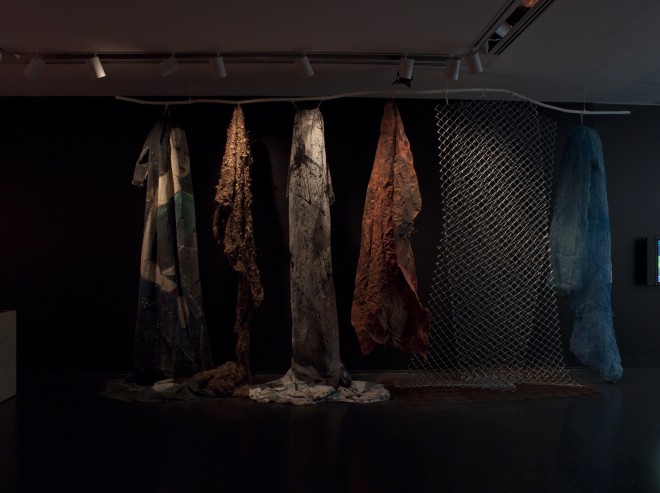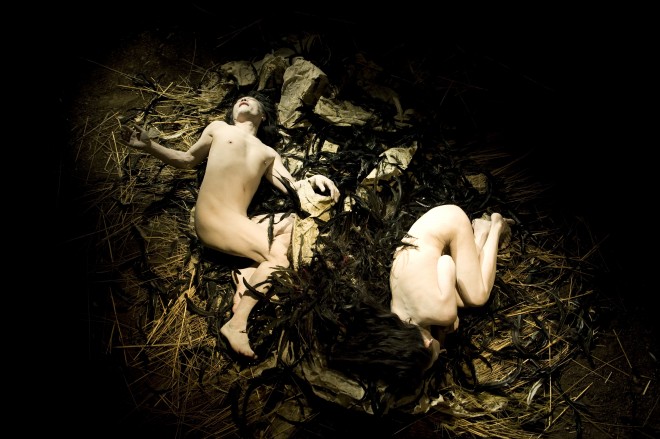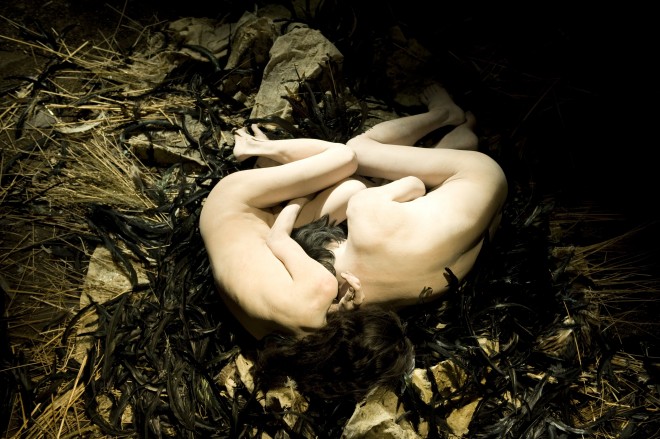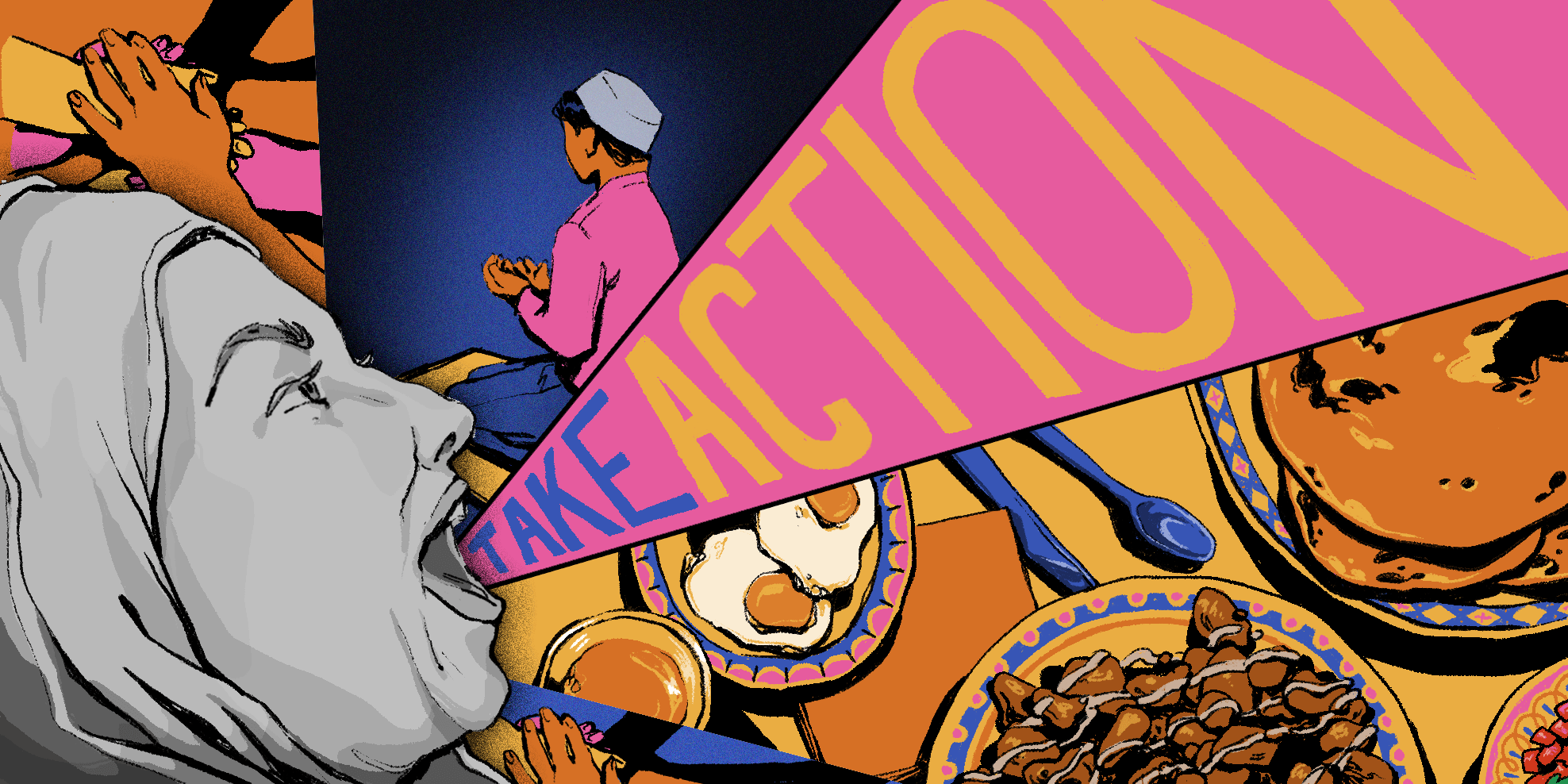Entering into the black, musky space at the end room of “Time is Not Even, Space is Not Empty,” the Museum of Contemporary Art’s Eiko & Koma Retrospective reveals a disheveled nest of black feathers with two skeletal bodies illuminated by a mercurial light. On taking a seat — either on an extended wooden bench or on a pillow on the floor — one is hushed by the intimacy of the artist-designed set; not elevated, the naked performers are but inches away, and the feathers are scattered —spreading from underneath their bodies to your feet and onto the earth-toned canvas walls of the space. One’s gaze is drawn to the reclining forms, painted white with black smears, matching the scenery. Through the vastness of trembling bird-hair a pale hand starts to slowly creep — as many have commented, the sudden awareness of their movement is indeed reminiscent of the after scenes of massacres. The nature of their dance is famously slow, through the years called Minimalist (the John Cage of dance) or simply poetic. For this particular performance piece, “Naked,” the movement is filled with a sense of tense, detached alienation, a quality that is heightened by the occasional opening of the artists’ bewildered black eye (they often dance with closed eyes), which gazes about without understanding, and shuts back into its primordial world. At times the bodies become drawn towards each other but to retract after a slight touch. For the duration of my sitting (the duo performed Nov. 8, 1-8 pm, Nov. 9-13, 1-5 pm, with breaks and the audience could freely roam in and out), they seemed always reverting into the tight grip of their own painful, isolated becoming.
The quality of becoming in the work comes through the overall pattern of physical extension. A bare chest, leg or finger, and then, as if the dim light of the humid den is too unbearable, a slow withdrawal. After a while, you become aware of their breath, and the way their ribs expand gradually becomes form and movement. The light, changing in scope and degree of coolness, moves to include or exclude the audience, and at generous moments reveals the pool of water behind the nest, otherwise cast in total shadow. The knowledge of this water demystifies the occasional sound of a drip or two. It also accounts for the feeling that this piece ought to be performed outdoors, perhaps inside a large, broken-down tree trunk of a swampy forest. In this humidity, you desire the lurking color of jungle green. Soon you discover that the white slowness of their mutation is the inevitable palette for many thoughts, both banal and fantastical.
At one point Eiko, lying on her back and facing me, stretched and slowly rolled her neck backwards until her head was only a few inches away from my feet. She suddenly started to open her eyes, glistening black-red in contrast to the color of her painted skin, and fixed her shiny blank gaze on me for several moments. I wondered then if I am a witness to the first moments of a life or its last painful breaths of existence. Holding her gaze was perhaps one of my most haunting experiences with art.

Installation view of Eiko & Koma, “Time is Not Even, Space is Not Empty,” MCA Chicago, June 24 – November 13, 2011. Photo: Nathan Keay, © MCA Chicago.
The retrospective spread across three rooms of the MCA, and together with old costumes, videos, various ephemera and photographic documentation is thorough and fascinating. At the entrance to the space there is a large open trailer decorated with colorful solid material. This is the stage for their moving installation “The Caravan Project”, originally performed as a free, open-air traveling installation in 1999, and revived this past August at the MCA.
The duo, born in Japan and living in the US since 1976 with their two children have, over four decades of collaboration, developed a unique, emotionally resilient style of dance and an almost shamanistic practice of art. The artists usually evoke nature and transience in their material and references. Embodying suffocating fish squirming on the edge of the Pacific Ocean in “Wallow” (1984), or more conceptually, in staged performances pieces like “Rust,” they are moving naked across a hanging steel fence. As with many artists that draw inspiration from the land, some works have a parallel function of ritual; having themselves completed an artist residency on the 92rd fl. of the World Trade Center in 2000, Eiko and Koma created a public performance in NYC’s Battery Park with reference to a cleansing and energetic revitalization of the space after the September 11th tragedy. “Offering,” a “public expression of mourning for the city’s loss,” drew much international acclaim and was reenacted by the artists in New York parks, as well as other US and international locations.
I’ve always wondered how artists of such spiritual presence become regular human beings. As I was entering the elevator to leave the exhibition, Eiko and Koma, on break from “Naked,” ran through the closing doors, laughing loudly. In the case of this duo, their primordial look was successfully done away with via the hasty touch of a brown bathrobe.
























